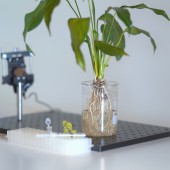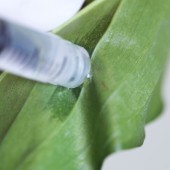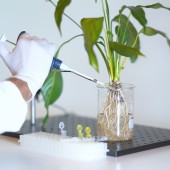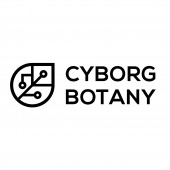Argus Nanosensors Inside Plants by Harpreet Singh Sareen |
Home > Winners > #106623 |
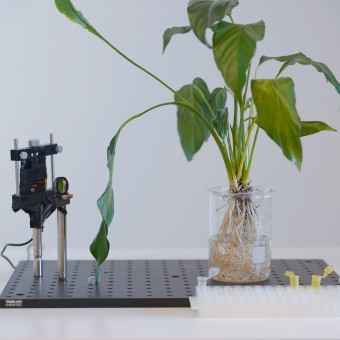 |
|
||||
| DESIGN DETAILS | |||||
| DESIGN NAME: Argus PRIMARY FUNCTION: Nanosensors Inside Plants INSPIRATION: This project is motivated by Flint water crisis, New Jersey school water problems, Austin Mar 2019 water advisory and many more. Current trend shows that by the time impurities are usually found in residential or agricultural, it is too late and has previously proven to be fatal. This is because continuous, cheap or off the shelf monitoring methods along river beds do not exist today. Argus on the other hand, provides an electricity free fully continuous water monitoring platform. UNIQUE PROPERTIES / PROJECT DESCRIPTION: Argus is a living plant that continuously monitors water for heavy metal impurities, with nanosensors inside its leaves. These sensors, of the order 2nm, are injected inside the leaves and stay within the intercellular space. A living plant continuously samples water in the environment and any impurities that come along with it. Such method of detecting heavy metal toxicity is real time, showing a visible output within 15mins to 2 hours, in contrast to current lab methods. OPERATION / FLOW / INTERACTION: Argus has nanonsensors injected inside the leaves of a living plant. A plant is like a natural motor in the environment operating twenty four hours without electricity. It continuously samples water and with that any impurities as well. Our nanosensors normally produce a visible glow of a specific light wavelength on the plant. When lead impurities from the environment come in contact with the nanosensors, this glow disappears to indicate that there are impurities in the environment. PROJECT DURATION AND LOCATION: This project was stated in 2017 and finished in 2019. It has been exhibited around the world such as Science Gallery Bangalore, Future of Everything WSJ Festival in NYC. |
PRODUCTION / REALIZATION TECHNOLOGY: Argus is a plant with DNA nanosensors inside it that detects Lead (Pb2 Heavy Metal). This novel method allows living plants to provide an optical readout of Lead in water. First, a DNAZyme is used as sensor assay inside leaves, double stranded DNA that breaks into single stranded on contact with Pb2 and binds to single walled carbon nanotubes. Following introduction of Pb2 ions, the fluorescence output is quenched and this reduction is proportional to the Lead(II) concentration. SPECIFICATIONS / TECHNICAL PROPERTIES: 457mm x 821mm x 304mm This includes height of the plant and the imaging setup to read from inside a plant TAGS: nanosensors, carbon nanotubes, living plants, DNA, water monitoring RESEARCH ABSTRACT: Industrial waste management has lead to depletion of water quality in rivers in many regions. Current processes of monitoring the water quality are not realtime. Our traditional sensors have been centered around synthetic and completely artificial techniques. We propose new nanosensors providing auxiliary sensing in conjunction with the natural system of a plant. These nanosensors provide an optical readout of lead in water by relying on a plants natural function near riverbeds. CHALLENGE: The following challenges had to be overcome to create world's first electricity free water monitoring platform. No current real time off the shelf sensors exist for Lead toxicity monitoring. Sample testing takes approximately 1 to 2 weeks. The chemical sensors inside plants also needed a digital connection with the digital world. This sensor scheme did not have to use electricity, since it relies on a plant acting like a motor. Such process is then able to sample water 24 hours a day. ADDED DATE: 2020-06-12 17:43:05 TEAM MEMBERS (2) : Harpreet Sareen and Pattie Maes IMAGE CREDITS: Images: Harpreet Sareen CC 4.0 Motion graphics: Jiefu Zheng |
||||
| Visit the following page to learn more: http://is.gd/EOWx7h | |||||
| AWARD DETAILS | |
 |
Argus Nanosensors Inside Plants by Harpreet Singh Sareen is Winner in Cybernetics, Prosthesis and Implant Design Category, 2020 - 2021.· Read the interview with designer Harpreet Singh Sareen for design Argus here.· Press Members: Login or Register to request an exclusive interview with Harpreet Singh Sareen. · Click here to register inorder to view the profile and other works by Harpreet Singh Sareen. |
| SOCIAL |
| + Add to Likes / Favorites | Send to My Email | Comment | Testimonials | View Press-Release | Press Kit |
Did you like Harpreet Singh Sareen's Cybernetics Design?
You will most likely enjoy other award winning cybernetics design as well.
Click here to view more Award Winning Cybernetics Design.


